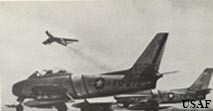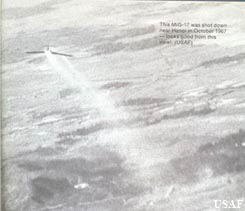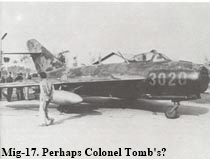|
What Ever Happened to The Hunters?
By Carlton W. Austin
The what, you say?
The Hunters, a 1958 movie of the Korean air war that was the clear inspiration for Top Gun, though much mention is made of an article in some obscure California magazine being the impetus for the Jack Epps, Jr., and Jim Cash screenplay. Even more interesting is that it foreshadowed a real-life drama from the Vietnam War, about which more later.
But first, the movie....
I say what happened to The Hunters? because as far as I can tell, it hasn't aired in over twenty years. Repeated inquiries to Twentieth Century Fox (Fox Studios now) have yielded no useful information; it isn't available on video. Yet it is one of the best war movies ever made, especially if you happen to like airplanes.
Based on a novel of the same name by James Salter, who was a real-life Korean War F-86 combat pilot, the story in the book, which was written in 1956 and re-released in 1997, follows a more philosophical--and more realistic--path than the movie. Salter obviously had high literary ambitions in this, his first novel, and he largely succeeded. The prose is stylish and bright, yet has the hard-edged feel of a Hemingway and the gritty emotional patina of a Steinbeck. The question of how we acquire and then deal with our sometimes neurotic obsessions is poignant and hits close to home: We have all at one time or another wanted "whatever" so badly it seemed our life would expire if we didn't get it or achieve it.
But the story itself was too introspective to make it whole-cloth into the movies; we're talking entertainment, after all. Not enough romance. Not enough conflict (of the relationship type). And not enough action. Not to mention that the ending of the book was…well, not to put too fine a point on it…lousy!
Listen for a moment as protagonist Cleve Connell (his last name was changed to Saville in the movie) tells Eiko, a Japanese girl he's befriended, about his consuming ambition:
There was a long pause. They lay in the cool grass, side by side, unwilling to do anything that might change it.
"What is your ambition?" she asked after a while.
Cleve closed his eyes. There had been many ambitions, all of them true at the time. They were scattered behind him like the ashes of old campfires, though he had warmed himself at every one of them. Now an ambition had been forced on him, but he hesitated. The innocence of a girl could have no values by which to judge him. What's your ambition?...
"The point is," he said, "you do a thing well. You devote yourself to it, and after a while pride arrives, plain, fatal pride. You’re happy in yourself, at last. You do something well, like your wanting to be in one good picture [Eiko's ambition], one really fine one.
"Well, here [in Korea, during the war] is the place where the fighter pilots live, and if you shoot down five planes you join a group, a core of heroes. Nothing less can do it."
"You've done that?"
"Oh, no. I've shot down one."
"A man like yourself, perhaps," she said.
"I hope so. I hope it was no frightened boy."
This is marvelous stuff, and I must tell you I loved the book, especially the writing. However, I also must tell you I loved the movie more—much more.
In fact, I think it's the greatest movie of jet fighter pilots at war ever made. And, with the possible exception of Top Gun, it has the best aerial sequences this side of Oshkosh. Directed by Dick Powell, who also did the great submarine movie The Enemy Below, also starring Robert Mitchum (and Curt Jergens, 1956), the movie uses tons of fantastic real-life footage of North American F-86s dueling with slightly older F-84s dressed up to look like MiG-15s. Best of all, screenwriter Wendell Mayes supplied the necessary condiments to the otherwise bland plot of the original.
Here's a thumbnail of the movie version, taken completely from my memory because, as I said, I haven't seen it in over twenty years. Forgive me if I've botched a couple of the details; I'm sure I'll hear from those of you who know better.
Squadron Commander Colonel "Dutch" Imil has a morale problem on his hands. It seems a North-Korean ace they've dubbed "Casey Jones" has been slashing through his patrols with mounting losses. Men are feigning illness to get taken off the flight schedule. Mission aborts due to phantom mechanical difficulties are rife. Everyone's afraid they'll be the next victim of the Red with the snake-eyes dice painted on his MiG's nose. What to do?
Out of the blue--literally--comes Dutch's World War II squadron mate Cleve Saville (played by ever stoical Robert Mitchum). He's been assigned as a replacement pilot. A little long-in-the tooth by fighter pilot standards, he's itching to realize a nagging ambition, one left unfulfilled in the last war. He's desperate to get the magical 5 air-to-air victories that would be his ticket into that rarefied hall of fame peopled by aces. But fickle fate seems to keep getting in the way.
Dutch wonders if "The Clever" still has the goods, so he sends him up against his best, Colonel "Monk" Moncavage. When Cleve quickly dispatches Col. Moncavage, Dutch mutters to himself, "The Iceman cometh." He now has his magic bullet for the mighty Casey Jones.
But first Cleve, who's been named section (four ship) leader, has to whip his crew into shape. And here's where it gets interesting.
First there's Lt. Corona, element leader (two-ship leader and wingman) and second in command in the section to Cleve. He's an okay guy but a little diffident for his leadership position. He can fly competently enough, though not well enough to please Cleve. Soon, though, fate relieves Cleve from the unhappy duty of demoting him, when, in footage of a famous F-100 (nothing's perfect) crash— the one where the landing plane suffers a loss of control due to hydraulic failure near the runway and hovers for an instant on its afterburning engine before smearing itself and its hapless pilot into a ball of burning jet-A—Corona buys the farm. Cleve decides to make the hot-shot, loud-mouthed kid who's fresh from flight school the new element leader.
 Everything is "Jake" (okay) to Lt. Ed Pell, played by the remarkable Robert Wagner in an early role. (Remember him in It Takes a Thief, a TV show back in the 60s? He played Alexander Mundy. Fred Astaire played his father. Great show, but I'm dating myself. You probably are more likely to have seen him lately in Austin Powers: The Spy Who Shagged Me.) Pell is the untamed mustang that Pete "Maverick" Mitchell aspired to in Top Gun, only more so, because Pell had no heart, at least not initially. To Pell, Corona was no "Goose." Pell's reaction to his loss was that Corona wasn't up to snuff as a pilot and that the result was, therefore, inevitable. Never mind that Pell had, on several previous occasions, "left his wingman" (remember Maverick again) Corona to go after a kill on his own and was about to be brought up on charges. Everything is "Jake" (okay) to Lt. Ed Pell, played by the remarkable Robert Wagner in an early role. (Remember him in It Takes a Thief, a TV show back in the 60s? He played Alexander Mundy. Fred Astaire played his father. Great show, but I'm dating myself. You probably are more likely to have seen him lately in Austin Powers: The Spy Who Shagged Me.) Pell is the untamed mustang that Pete "Maverick" Mitchell aspired to in Top Gun, only more so, because Pell had no heart, at least not initially. To Pell, Corona was no "Goose." Pell's reaction to his loss was that Corona wasn't up to snuff as a pilot and that the result was, therefore, inevitable. Never mind that Pell had, on several previous occasions, "left his wingman" (remember Maverick again) Corona to go after a kill on his own and was about to be brought up on charges.
Finally, there's the weak-kneed Lt. Carl Abbott, played by Lee Philips, who resents being recalled from the reserves to fight another terrifying war. (Can't say I blame him, there.) After several aborts due to presumed mechanical difficulties, Cleve is about to ditch Abbott. Only Abbott, mouse that he is, still has an ego; he doesn't want to embarrass himself before his stunningly beautiful wife, played by May Britt, who waits patiently in Japan for his every R&R. Will Cleve give him another chance? Will he talk to his wife when he goes to Japan and tell her that he, Abbott, is doing fine and is a valued team player?
Big-hearted Cleve caves in and agrees to look her up. And perhaps predictably by today's standards--adultery wasn't nearly as prevalent nor as socially acceptable as it is today, at least in some circles--he falls for Abbott's wife. Now how would it look if something happens to Abbott?
Back in the skies over the Yalu River, Pell racks up kill after kill, as Cleve struggles through a drought. It seems the kid is always in the right place at the right time. Cleve's resentment of the youngster grows with each mission; and with each mission, it seems, Pell adds another notch to his gun. War is Jake to him: "I'm a killer, man! I cut 'em up, ya know?"
Meanwhile, Abbott's terror nearly reaches the breaking point when the vaunted Col. Monk Moncavage is greased by Casey Jones, an event that delights Pell, who sees it as just one less competitor for Casey. The only hope Cleve has now is if he can get a crack at Casey before the kid.
Then, in a climactic scene, Cleve and Casey duke it out in real knife fight in the sky. Boy, there's some nifty stick-work here. Perhaps predictably, Cleve gets his oh-so-satisfying victory over the Korean ace, even though he may never achieve ace status himself.
Why?
Because moments before Cleve got Casey, Casey had shot down Abbott. Now Cleve can't just leave him to swing helplessly earthward on his parachute, headed for a North Korean prison, maybe worse. No. Cleve lands the hearty Sabre jet near where Abbott goes down and quickly opens fire with his 45 automatic on the approaching North Korean Regulars.
They're surrounded now; the enemy is closing in. All seems lost. But wait! Who's this circling and firing those six big fifty-caliber guns, hosing down the bad guys, keeping them at bay? It can't be. Yes, it's the egotistic, self-serving kid with the cigar: Pell!
Who would've thunk it?
Exhausting his ammo--and his fuel--Pell bails out, landing a little too conveniently right by his comrades. He joins them, and they make a break for the border--or is that the thirty-eighth parallel?
Well, you've probably guessed the too perfect, 1950s’ ending: They all make it back to a hero’s welcome. Cleve decides being an ace might not be the most important thing in the world after all, Pell has found redemption in his unselfish act of bravery, and Mr. and Mrs. Abbott stay that way. A satisfying ending. Not too many of those to be found these days.
But what about the Vietnam war connection? On 10 May 1972, two U. S. naval officers flying a McDonnell-Douglas F-4J PhantomII shot down three MiG-17s. The last MiG was piloted by the notorious Colonel "Tomb" of the North Vietnamese Air Force, a superior fighter pilot with 13 victories over U.S. aircraft. Lt. Randall Cunningham, pilot, and Lt. (j.g.) Willie Driscoll, Radar Intercept Officer (RIO), of VF-96, flying off the USS Constellation (CVA-64), became the first of only three Vietnam War aces.
Cunningham: "As I looked back over my ejection seat, I got the surprise of my life: There was the MiG, canopy-to-canopy with me, barely 300 feet away! I could see a Gomer leather helmet, Gomer goggles, Gomer scarf...and his intent Gomer expression.... There was no fear in this guy's eyes as we zoomed some 8,000 feet straight up." (From Randall Cunningham's Fox Two.) 
Surprising how life does imitate art sometimes. Cunningham's account of this ferocious air-to-air encounter will be the focus of an upcoming article. But for now, I'll let the "Clever" have the floor one last time: "I want this to be the end, anyway. And when you make your last appearance, before whatever audience you have, you want it to be your real performance, to say, somehow, remember me for this."
Well, I remember, Cleve. And as for the movie, The Hunters, if you haven't seen it, you're in for a real treat, should it ever come back to TV, cable, or be made into a video. I know I'd love to see it again
back to top
|